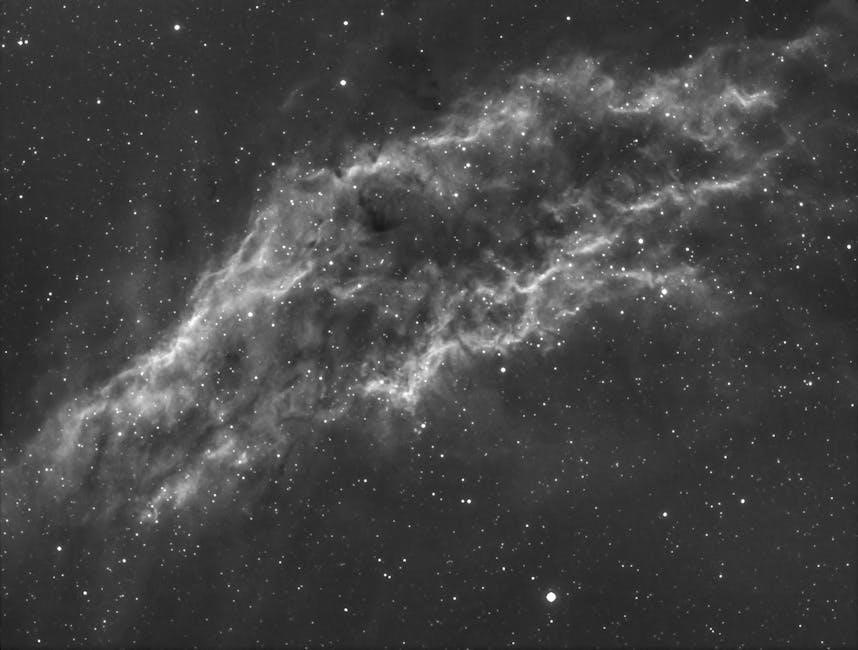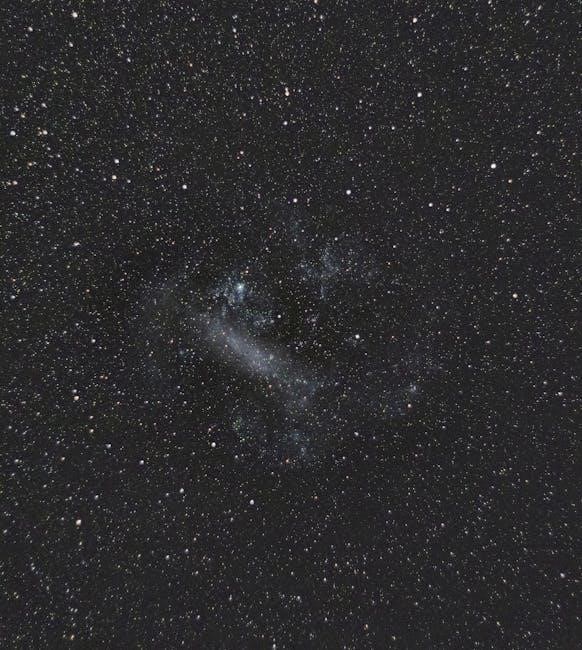Dark matter is a hypothetical form of matter invisible to light, comprising 25% of the universe’s mass-energy. Its existence explains galaxy rotations and cosmic structures.
What is Dark Matter?
Dark matter is a non-luminous, hypothetical form of matter that does not emit, absorb, or reflect light, making it invisible to telescopes. It constitutes approximately 25% of the universe’s total mass-energy density, while visible matter accounts for only about 5%. Dark matter’s existence is inferred through its gravitational effects on visible matter, radiation, and the large-scale structure of the universe. It is composed of particles that do not interact with electromagnetic forces, such as photons, but do interact through gravity. The most widely discussed candidate for dark matter is weakly interacting massive particles (WIMPs), though other theories, like axions, are also explored. Despite its elusive nature, dark matter is crucial for understanding galaxy rotation, cosmic structure formation, and the universe’s expansion dynamics.
The Importance of Dark Matter in Cosmology
Dark matter is a cornerstone of modern cosmology, playing a pivotal role in understanding the universe’s structure and evolution. It provides the gravitational scaffolding for galaxy formation and clusters, explaining the observed distribution of visible matter. Dark matter’s presence is crucial for maintaining galaxy rotation curves and the stability of cosmic structures. Without it, galaxies and galaxy clusters would not hold together as observed. It also influences the universe’s expansion dynamics, contributing to the overall mass-energy budget. Despite its elusive nature, dark matter is essential for reconciling theoretical models with observational data, making it a fundamental component of our understanding of the cosmos.
Historical Background
The concept of dark matter emerged in the 1930s with Swiss astrophysicist Fritz Zwicky’s observations of galaxy clusters, suggesting unseen mass. This idea gained traction in the 1980s.
Early Evidence of Dark Matter
The early evidence of dark matter dates back to the 1930s when Swiss astrophysicist Fritz Zwicky observed the Coma galaxy cluster. He noted that the galaxies within the cluster were moving at much higher velocities than expected, suggesting the presence of unseen mass. This discovery led him to propose the existence of dunkle Materie, or dark matter. Zwicky’s findings were initially met with skepticism but laid the groundwork for future research. By the 1970s, observations of galaxy rotation curves by Vera Rubin and Kent Ford provided further evidence, showing that stars in the outer regions of galaxies orbited the center at unexpectedly high speeds, implying an unseen mass distribution. These early observations collectively indicated that dark matter plays a critical role in the structure and dynamics of the universe, making it a cornerstone of modern astrophysics.
The Development of the Dark Matter Paradigm
The dark matter paradigm emerged as a unifying explanation for multiple astronomical observations. Initially controversial, it gained acceptance as more evidence mounted. By the 1970s, Vera Rubin and Kent Ford’s observations of galaxy rotation curves confirmed that stars orbited galactic centers at constant velocities, implying unseen mass. This led to the widespread adoption of dark matter as a fundamental component of the universe. The paradigm solidified in the 1980s with the development of the cold dark matter (CDM) model, which explained cosmic structure formation. Today, dark matter is a cornerstone of the Lambda-CDM model, the standard cosmological framework, supported by simulations and theoretical models.
Properties of Dark Matter
Dark matter is non-luminous, non-baryonic, and interacts primarily through gravity. It does not emit or absorb light, making it invisible and detectable only indirectly.
Key Characteristics of Dark Matter
Dark matter is a non-luminous, non-baryonic form of matter that does not emit or absorb light, making it invisible to electromagnetic radiation. It interacts primarily through gravity, influencing the formation and dynamics of galaxies and galaxy clusters. Dark matter is composed of particles that are believed to be weakly interacting and massive, such as WIMPs (Weakly Interacting Massive Particles) or axions. Its non-relativistic nature and lack of electromagnetic interaction make it elusive to direct detection. Despite its invisibility, dark matter’s presence is inferred from its gravitational effects on visible matter and the large-scale structure of the universe.
Dark Matter and Its Interaction with Normal Matter
Dark matter interacts with normal matter primarily through gravitational forces, shaping galaxy structures and influencing cosmic dynamics. Beyond gravity, its interaction is minimal, as it does not emit or absorb light. Weak interactions, if any, are rare and difficult to detect. Experiments like DAMA and LUX-ZEPLIN aim to detect such interactions, but results remain inconclusive. The Standard Model of particle physics does not include dark matter, prompting theories like WIMPs or axions. These particles may interact via unknown forces, but their elusive nature complicates detection efforts, leaving dark matter’s true interaction with normal matter largely a mystery requiring further exploration.

Theoretical Models
Cold Dark Matter (CDM), axion-like particles, and thermal dark matter are leading theoretical models explaining dark matter’s nature and cosmic role, supported by simulations and observations.
Cold Dark Matter (CDM)
Cold Dark Matter (CDM) is a widely accepted model where dark matter particles move slowly compared to light, making them gravitationally dominant. This model predicts that dark matter consists of heavy, weakly interacting particles that decouple early in the universe. CDM explains the large-scale structure of the universe, including galaxy formation and clustering, as it provides the necessary gravitational scaffolding for baryonic matter to clump together. The ΛCDM cosmological model, incorporating CDM, is supported by numerous observations, such as the cosmic microwave background and galaxy rotation curves. Its success lies in its ability to predict the distribution of matter on cosmic scales, making it a cornerstone of modern cosmology.
Thermal Dark Matter and Freeze-Out Mechanism
Thermal dark matter refers to particles that were once in thermal equilibrium with the early universe. As the universe expanded and cooled, these particles “froze out” when their interaction rates dropped below the Hubble expansion rate. This freeze-out mechanism determines their relic density, which matches the observed dark matter abundance for particles like WIMPs (Weakly Interacting Massive Particles). The process relies on the particles’ annihilation cross-sections, which regulate how efficiently they pair-annihilate. Thermal dark matter provides a natural explanation for the universe’s dark matter density, making it a cornerstone of many theoretical models. This mechanism aligns with cosmological observations and particle physics frameworks.
Axion-Like Dark Matter
Axion-like dark matter refers to hypothetical particles resembling axions, which are ultra-lightweight and interact weakly with normal matter. Originally proposed to solve problems in quantum chromodynamics (QCD), axions have gained attention as dark matter candidates. Unlike WIMPs, axions interact through pseudoscalar fields, making them nearly invisible. Their light mass and weak interactions allow them to evade detection while contributing significantly to the universe’s mass. Axion-like particles can be produced in the early universe through various mechanisms, such as vacuum misalignment or decay of heavy particles. Their detection relies on indirect methods, like astrophysical observations or laboratory experiments, where they interact with normal matter under specific conditions. Axions provide a compelling solution to the dark matter puzzle, offering a natural explanation for the observed cosmic phenomena.

Dark Matter and Structure Formation
Dark matter provides the gravitational framework for cosmic structure formation, enabling galaxies and galaxy clusters to coalesce and maintain their observed distributions and stability.
Galaxy Rotation Curves and Dark Matter
The observation that stars in the outer regions of galaxies orbit as quickly as those near the center led to the concept of dark matter. Without dark matter, stars at greater distances from the galactic center should orbit more slowly, following Newtonian dynamics. However, the measured rotation curves of galaxies are flat, indicating that stars maintain a constant orbital velocity regardless of their distance from the center. This discrepancy implies the presence of unseen mass distributed in a halo around the galaxy. Dark matter provides the additional gravitational force necessary to explain these flat rotation curves, confirming its critical role in galactic dynamics and structure.
Dark Matter in Cosmological Simulations
Cosmological simulations rely on dark matter to model the formation and evolution of cosmic structures. These simulations treat dark matter as a collisionless fluid, using particles to represent its distribution. They show that dark matter halos provide the gravitational scaffolding for galaxy formation and cluster growth. Simulations predict the large-scale distribution of matter, matching observations like the cosmic web. Challenges include resolving small-scale structures and addressing discrepancies like the “cusp-core” problem. Despite these, simulations remain a cornerstone in understanding dark matter’s role in shaping the universe, offering insights into its properties and interactions on cosmological scales.
Detection Methods
Detection methods for dark matter include direct detection experiments, indirect searches via cosmic rays and gamma rays, and observations using instruments like Fermi LAT.
Direct Detection Experiments
Direct detection experiments aim to observe dark matter particles interacting with normal matter in highly sensitive detectors. These experiments, like DAMA, LUX-ZEPLIN, and XENON1T, use ultra-pure materials to detect rare nuclear recoils caused by dark matter particles. Conducted deep underground to minimize cosmic ray interference, these detectors employ sophisticated shielding and cooling systems. While no conclusive signals have been detected yet, ongoing advancements in sensitivity and technology continue to refine the search. These experiments are crucial for identifying dark matter’s properties, bridging particle physics and cosmology, and potentially validating theoretical models like WIMPs. Their results, whether positive or negative, significantly impact our understanding of the universe’s composition.
Indirect Detection Methods
Indirect detection methods seek to identify dark matter through its annihilation or decay products, such as gamma rays, neutrinos, or cosmic rays. These particles are emitted when dark matter particles interact in dense regions like the galactic center or dwarf galaxies. Experiments like Fermi LAT and AMS-02 on the ISS monitor these high-energy signals to detect dark matter signatures. Gamma-ray observations from regions with high dark matter concentrations are particularly promising. While no conclusive signals have been found, ongoing efforts refine detection techniques, enhancing sensitivity to dark matter’s elusive interactions. These methods complement direct detection, offering alternative pathways to uncover dark matter’s nature.
Fermi LAT Dark Matter Searches
The Fermi Large Area Telescope (LAT) is a space-based observatory playing a crucial role in dark matter detection through indirect methods. It searches for gamma-ray signals from dark matter annihilation or decay in regions like dwarf spheroidal galaxies and the galactic center. Fermi LAT’s high-energy resolution allows it to detect faint signals, such as monochromatic gamma rays, which could indicate dark matter interactions. While no conclusive dark matter signal has been detected, Fermi LAT’s observations have set stringent limits on dark matter models, particularly for weakly interacting massive particles (WIMPs). Its findings complement other experiments, advancing our understanding of dark matter’s elusive nature.

Current Research and Future Directions
Research focuses on new particle accelerators and black hole observations as cost-effective alternatives for detecting dark matter, addressing budget constraints and advancing theoretical models.
New Particle Accelerators for Dark Matter Detection
New particle accelerators are being developed to detect dark matter, addressing funding constraints and advancing theoretical models. These accelerators will facilitate high-energy collisions to produce particles that could interact with dark matter. Scientists aim to create controlled environments simulating cosmic conditions, allowing precise measurements of potential dark matter interactions. This approach complements traditional detection methods, offering new avenues for discovery. By leveraging cutting-edge technology, researchers hope to uncover the elusive nature of dark matter, potentially revolutionizing our understanding of the universe.
Black Holes as Natural Alternatives for Dark Matter Research
Black holes are emerging as natural alternatives for dark matter research, offering cost-effective solutions amid funding cuts. Supermassive black holes can act as cosmic engines, smashing particles at near-light speeds to replicate conditions found in high-energy accelerators. This approach could potentially replace expensive facilities, providing a more accessible way to study dark matter interactions. Researchers suggest that black holes might naturally produce the high-energy collisions needed to detect dark matter particles. This innovative method aligns with theoretical models, offering new insights into the elusive nature of dark matter without relying on costly infrastructure.



0 Comments